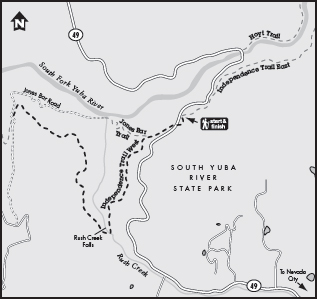RATING |
|
 |
DISTANCE |
|
4.0 miles round-trip |
HIKING TIME |
|
2 hours |
ELEVATION GAIN |
|
Negligible |
HIGH POINT |
|
1,450 feet |
EFFORT |
|
Easy Walk |
BEST SEASON |
|
December to June |
PERMITS/CONTACT |
|
South Yuba River State Park Bridgeport Visitor Center, |
|
|
(530) 432-2546, www.southyubariverstatepark.org |
MAPS |
|
South Yuba River Park |
|
|
(download at www.parks.ca.gov) |
NOTES |
|
Wheelchair accessible; dogs allowed |
THE HIKE
The first “wheelchair wilderness trail” in the United States, this historic flume trail allows wheelchair users the chance to ride off-pavement.
GETTING THERE
From Interstate 80 at Auburn, drive north on Highway 49 for 27 miles to Nevada City. Continue on Highway 49 for 8 miles past Nevada City to the trailhead on the right side of the highway, shortly before the South Yuba River bridge. Park at the pullout at the trailhead, or if there are no spaces available, at one of several pullouts farther north.
THE TRAIL
Most wheelchair-accessible trails have one major drawback: they are paved. Although this may seem like a necessity, wheelchair riders often say that paving the ground takes away from the nature experience. After all, most people go outdoors to get away from man-made materials like pavement.
That makes the unpaved South Yuba Independence Trail a stroke of genius and a blessing. It’s the first identified “wheelchair wilderness trail” in the United States, and it leads a total of 6.0 miles on hard-packed dirt and over wooden flumes along the Yuba River canyon.

Everything about this trail has been done right. For much of its length, two paths run parallel, one designed for wheelchairs and one for hiking boots. Outhouses built for wheelchair riders are positioned along the trail, as well as accessible platforms for picnicking and fishing on Rush Creek. A nonprofit group called Sequoya Challenge maintains the trail in partnership with California State Parks.
The trail was originally built in 1859, not as a hiking trail but as a canal to carry water from the South Yuba River to a hydraulic mining site in Smartsville, 25 miles downstream. Consisting of rock-lined ditches with adjacent paths for ditch tenders, plus wooden flumes (similar to bridges) allowing passage over creeks, the canal followed a nearly level contour along the steep hillsides above the South Yuba River.
At the trailhead, you have a choice of hiking east or west. (The trail does not loop; if you want to walk the whole route, you must go out and back in both directions.) The trip described here heads west, or right. In the first 50 yards from the trailhead sign, you must duck your head and pass through a tunnel under Highway 49. The noise of highway traffic is overbearing at first, but soon dissipates. The path travels through a densely wooded forest of oaks and pines. In the first 0.25 mile, you’ll pass by a roofed platform that provides a scenic overlook of the South Yuba River canyon. In the next 0.5 mile, you’ll cross over a few wooden flumes or bridges. Admire the handiwork of those who built this trail, and also those who maintain it.

Wooden flumes remaining from the mid-1800s Gold Rush curve around the canyons above the South Yuba River.
At 1.0 mile out, you emerge from the forest at an amazing cliff-hanging flume, its wooden boards making a horseshoe-shaped turn around the back of a canyon. Above and below it, Rush Creek Falls flows over polished granite in a multitiered cascade. This area is known as the Rush Creek Ramp at Flume 28. Here, volunteers built an intricate wooden ramp spiraling 520 feet down from the flume to the swirling edge of Rush Creek. It’s a fine place for all trail users to picnic, fish, or just admire the flow of water.
From here, the “west” segment of the South Yuba Independence Trail continues for another 1.0 mile to Jones Bar Road, through more forest and across more flumes. There you must turn around and hike back, making a 4.0-mile round-trip.
GOING FARTHER
You can also hike the eastern section of trail from the parking area, a 5-mile round-trip that includes more flumes, views of the river and foothills, and springtime wildflowers.


